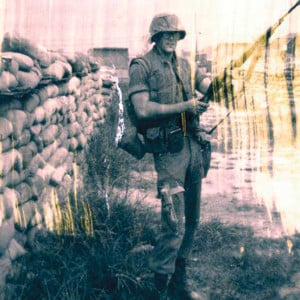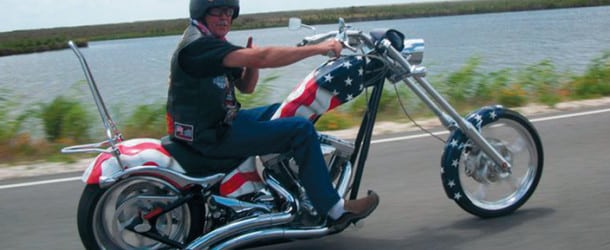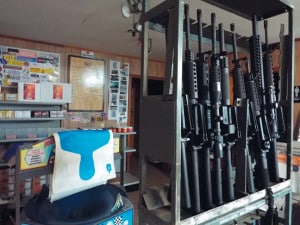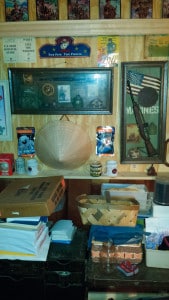Career Marine Uses His Love Of Motorcycles To Help Area Vets
By Brad Goins
Lee Perkins was born Nov. 8, 1947 — two days before the anniversary of the founding of the Marine Corps. He’d later ask his mom why she didn’t wait another two days to give birth.
When he graduated from LaSalle High School in South Bend, Ind., Perkins went straight into the Marine Corps. He was sent to several U.S. bases until he wound up getting his orders to go to Vietnam, where he arrived in April, 1968.
He served in the conflict for 30 months, extending his tour twice. Before his second re-up ended, U.S. troops were pulled out of Southeast Asia. Perkins spent six months in Okinawa, then returned to the states.
When he came back, he got a truck-driving gig hauling goods from Chicago to Toledo and back. At some point, Perkins had a moment of illumination when he realized this could become a 45-year-long job.

And he stayed there 22 1/2 years.
When he’d first left the Marines, he’d gotten to the point that he’d been selected for staff sergeant. When he returned, he had to begin as a corporal with no time and no grade. Within 9 months, he’d become a staff sergeant meritoriously and an accelerated staff sergeant.
He was sent to Parris Island, S.C., where he started off by working as a drill instructor for three years. He oversaw three platoons as an asst. drill instructor and six platoons as a senior drill instructor.
He went on to serve in Okinawa and other Japanese locales as a warrant officer. He then returned to Parris Island, where he worked his way up the ladder of warrant officer ranks. (A warrant officer is a liaison between enlisted men and officers. He can hold technical jobs, but not leadership positions. Many of the best Marine NCOs wind up being warrant officers.)
Given that Perkins spent 26 years in the USMC, it almost goes without saying that something about the Corps must have meant a great deal to him.
“I miss it right now, today,” says Perkins. “I go to bed at night missing it. I wake up in the morning missing it.
“I tried to go back in during the first Desert War. I [also] tried to take my daughter [Nikki]’s place [in Afghanistan. She eventually wound up sustaining a severe injury to one of her knees, which was recently replaced. She is an 8-year Marine].”
Specific aspects of the Marines that appeal to Perkins are the primary role of leadership as well as the exceptional motivation of the individuals who make up the Corps. He’s also impressed with the recruits of the present, who, he says, are “more informed, more intelligent” than those of the past. He notes that while today’s armed forces are all voluntary, most members of the infantry in Vietnam had been drafted and many didn’t want to be there.
As much as he missed the Corps, Perkins’ life hardly came to an end when he left the Marines.
At one point, when he was living in Georgia, he got a call from an old Marine friend living in Southwest Louisiana, who told him he had to relocate to the area to “save a warehouse” that was then owned by ARCO. When Perkins saw the condition of the place, he told his old buddy, “friends don’t do this to friends.”
But Perkins stayed on in the Lake Area. One day, he got a call from another former Marine — John DeRosier, who is now the Calcasieu Parish District Attorney. DeRosier had been a machine gunner in Vietnam. DeRosier had heard that Perkins was retired. He called Perkins and told him, “If I’ve gotta work, you gotta work.”

As you’d expect, the Gun Club has loads of ammunition, weapons, targets, posters, bumper stickers and so forth.
It also has three cats who lounge around the club and its front porch. Each year, a litter of owls is delivered on the premises. One year, an owl was abandoned. Perkins raised it until it was ready for wild life. He has plenty of photos of the owlet perching on top of the heads of Gun Club employees. He says it liked to pull out his wife’s barrettes.
On a busy day, 35-40 members shoot at the Gun Club in a single afternoon.
Motorcycles And Guns
If you ask Perkins what he’s all about, he might say “motorcycles and guns.” He likes to say, “you can never have enough of either.” (Right now, he’s up to nine motorcycles.)
Perkins uses a similar saying specifically for guns — “If you can count how many guns you have, you don’t have enough.”
Perkins and his wife Kay ride with a local chapter of the Combat Veterans Motor Association. Perkins’ biker name — Arsenal — is obviously fitting.
The star of Perkins’ cycle collection is his Big Dog Chopper K-9. This chopper stretches out a long way. The chassis of the bike is decorated entirely in an American flag motif; the American flag is most recognizable on the bike’s fuel tank.
Perkins points out that the bike’s meticulously hand-painted design not only includes painted representations of the actual stiches of the American
flag, but also shows some of the stitches being pulled out — presumably by the fast speed at which the bike is travelling. Miniscule white brush
strokes mimic unraveling stitches.
The Big Dog Chopper K-9 was produced in an edition of 10,000, and Perkins bought No. 10,000 when he happened upon it in a shop. He says he got the 10,000th bike entirely by chance.
Among other motorcycles in the collection are a Harley Screamin’ Eagle 105 and a C90 Boulevard. Kay rides a bright blue Voyager three-wheeler. (The two have been married 45 years.)
And Then There’s The Man Cave
Perkins’ man cave alters all preconceptions of what the man cave is. It’s enormous; includes a bathroom, a playroom, two large gathering rooms, and several large tables (from the former Sha Sha’s) for visiting.
Another small room in the man cave is what Perkins calls the “family room.” It’s devoted to memorabilia of the Perkins family’s recent military history. There’s a display of Perkins’ medals that he was given on his retirement from the Marines. And then there’s the medal display of his father, who earned two Bronze Stars, one Silver Star and two Purple Hearts in World War II (and lived on until 1997; he served as a half-track commander in the European
Theater. The half-track is a powerful transport vehicle with a traction system that resembles a tank’s. In World War II, the half-track was often outfitted with mortars or anti-tank or anti-aircraft guns.).
In the family room, there hang paintings of another World War II veteran — Perkins’ uncle, who painted a variety of scenes on large window panes that were then placed in windows.
In other parts of the man cave, there are vast displays of additional military paraphernalia and memorabilia. One item on display is the “short-timers'” Jim Beam bottle that soldiers used to buy in Vietnam when they reached their last week of duty. The bottle, which was in the shape of two infantry boots topped with a helmet, was sealed with an orange string. Like most Marines, Perkins put the orange string in his helmet to indicate that he was in his last week.
He also displays the traditional Vietnamese conical hat (the “non la”) that he mailed home to his mother during the war.
A truly bizarre display from Southeast Asia days is that of two “death cards” carried or handed out by Vietcong. Each card promised the Vietnamese equivalent of $100 if the bearer brought in a dead U.S. Marine.
If you’re a weapons aficionado, there’s plenty to be seen in the man cave. There’s a knife Perkins’ uncle brought back from war-time Japan; in its handle is an imitation monkey claw. There’s a USMC 1918 trench knife; Perkins showed me the ball-bearing-shaped metal sphere embedded at the end of the handle which could be used as a sort of blackjack on enemy troops. There are also wicked-looking knives Perkins found in Vietnam and the Sinai Desert. He showed me that the Vietnamese troop’s knife was shorter than the officer’s because it had been sharpened so often.
The man cave has a Wall of Honor with memorabilia and commemorations of veterans who have died or were killed in battle.
Some displays in the man cave have nothing to do with war or guns or motorcycles. There are, for example, extremely long chains containing thousands of keys. Perkins and his wife — who are dyed-in-the-wool collectors — once found a curious patch of land in South Carolina that was, for whatever reason, full of keys. Since then, the couple has added every key it finds to the chains, which stretch all the way across the large room where they hang.
Many of the thousands of items that can be seen in the man cave are contributed by vets from the area. Perkins estimates that 30 to 40 vets have brought in items. While it would take well over a day to look at everything that’s already there, the place is huge and I’m sure there’s room for more.
A Gathering Place
Although this conglomeration of museum, entertainment center and out-of-the-ordinary collections is obviously a man cave, it’s also a gathering place for vets. Perkins believes he’s entertained as many as 30 vets in the man cave at a single time.
Among the artifacts in the caves is the series of “subway straps” from cattle cars that hang from the ceiling. Perkins jokes that inebriated guests can use these straps to hang on to as they make their way to the man cave’s bathroom.
The man cave began as nothing more than a 20 by 20 shed that provided shelter for members’ bikes. Perkins’ wife suggested that the bikes be moved outside and stored under a tarp so that the structure could be used as a place for members to congregate.
The amount of memorabilia and the number of visitors made it necessary to make periodic expansions of the original building. Today, the work goes on, as Perkins moves toward the completion of an enormous deck-like structure built entirely of new boards of wood. This very wide walkway, which stretches out for several dozen feet, is directly adjacent to the man cave.
It is quite possible that the gatherings will get even bigger as time goes by.
City Of Refuge
Perkins, Kay and other locals are part of the Combat Veterans Motorcycle Association — the largest motorcycle organization in the U.S.
The local chapter organizes fundraisers on a regular basis, but keeps no money for itself; all funds go to the City of Refuge, which is a homeless shelter for veterans in Vinton.
In the last year of fundraising, the local chapter donated $30,000 to the City of Refuge. The group also contributes work; it just painted the City’s truck.
December 3 will see the groundbreaking of the new building for the City of Refuge. Perkins’ local motorcycle chapter is only one of a number of groups that have contributed to this project. Local interests that have played a part include American Legion Post 1 (of which Perkins is a member).
The Habit Of Getting Things Done
Perkins is walking, talking proof that a person can build a full and active life around the lore and technical aspects of bikes and guns.
His life shows the value of staying active past retirement age. His activities extend beyond biking and the following of gun trends to fund-raising, networking with Marines and vets and collecting. He even indulges in the feeding and petting of alligators. (In the water behind Perkins’ home are live alligators, whom Perkins has turned into pets. In one video, Ally the alligator walks up out of the water towards Perkins, who feeds Ally chunks of chicken from his hand. Ally then lies still on the grass while Perkins scratches his scales at length. The alligator seems to be quite content. In another video, a second, younger and more timid alligator, named Puller [after one of Perkins’ heroes, Marine Gen. Chesty Puller] climbs up out of the water and tentatively takes barbecued chicken from the hand of Perkins’ daughter Nikki.)
It’s as if the more he ages, the more active Perkins becomes. He doesn’t find the prospect of new projects daunting. It’s an approach to living that seems to suit him well.






















Comments are closed.